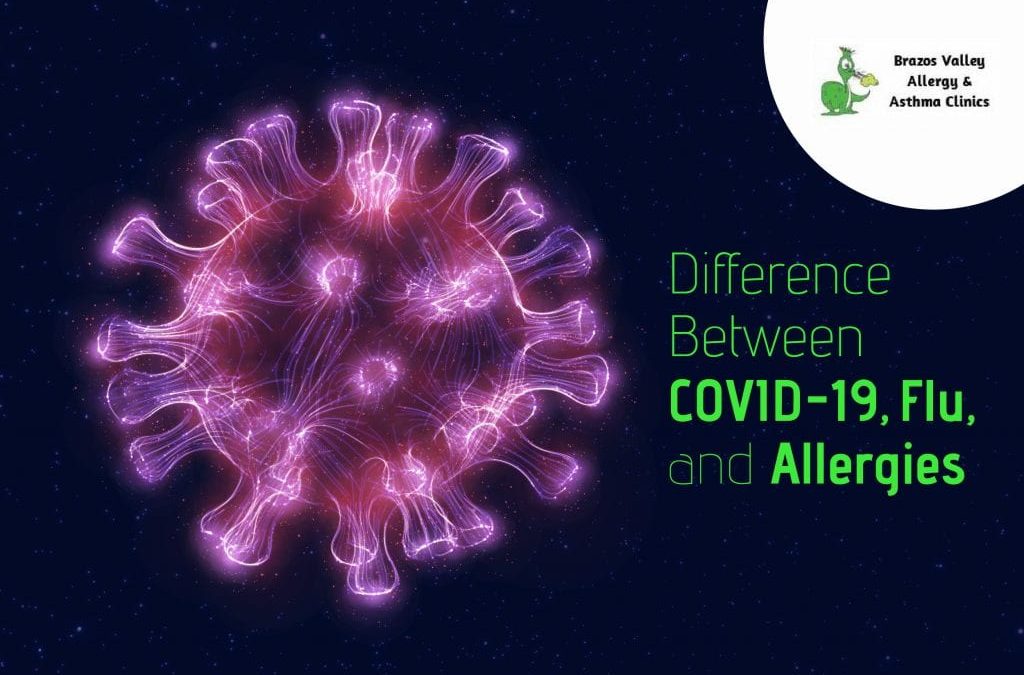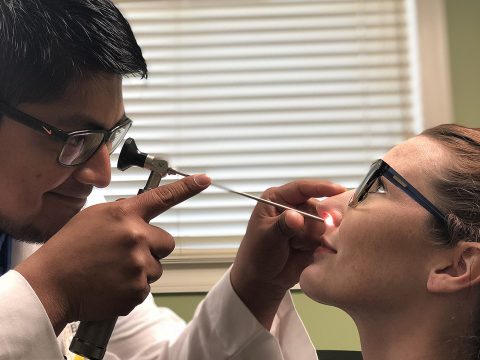- 979-485-9287
- office@bvallergy.com
-
 979-251-7804
979-251-7804
Difference Between COVID-19, Flu, and Allergies

Foods that Trigger Asthma Attacks
February 17, 2020
COVID-19: Prepare for the New Normal
April 20, 2020Overview
The United States of America has taken its toll on the COVID-19 pandemic. The country has become the pandemic’s epicenter last March 26, 2020. It now holds a record of 406,697 cases and 13,868 dead as of Tuesday, April 8, 2020. It brought a spike on unemployment due to businesses closing down due to mandatory quarantine and fear. A lot of people might be stressing and panicking whether or not they have COVID-19 especially when spring allergies are here. The paranoia is understandable for the main symptoms of COVID-19 can overlap on some common illnesses like flu or allergies. So here’s how it differs from the common flu and allergies.
What is COVID-19?
A new virus strain called the Severe Acute Respiratory Syndrome Coronavirus 2 (SARS-CoV-2) is causing the global pandemic that is affecting hundreds and thousands of people with the Coronavirus Disease (COVID-19), which is a highly infectious respiratory disease. According to the World Health Organization (WHO), the virus is from the Coronaviruses (CoV) family that causes flu-like symptoms ranging from mild to severe respiratory cases. The Middle East Respiratory Syndrome (MERS-CoV) and Severe Acute Respiratory Syndrome (SARS-CoV) are examples of this.
WHO also continues that the virus spreads through contact with an infected person from their respiratory droplets produced from their cough or sneeze. Additionally, a study says that the virus can live on some surfaces for hours. It states that it is detectable in aerosols for up to three hours, up to four hours on copper, up to 24 hours on cardboard and up to two to three days on plastic and stainless steel.
Studies state that asymptomatic transmission is present. It shows that people who don’t show any symptoms of sickness are one of the major drivers of the spread. Alex Azar, the US Secretary of Health and Human Services, says in reference to asymptomatic cases is that people should stay in their homes for self-quarantine to let hospitals focus more on those who are showing severe signs of infection.
Symptoms of COVID-19
The difference of COVID-19 from flu and allergies is that runny nose and sneezing are rare and it doesn’t come with itchy eyes. It takes 2-14 days after the exposure for the symptoms of the COVID-19 show. Its severity ranges from mild to critical respiratory symptoms. Fever, cough, and difficulty in breathing are its primary symptoms. In addition, studies also show that the loss of smell and taste is the strongest predictor of a COVID-19 infection. There are severe cases where the virus causes pneumonia, severe acute respiratory syndrome, kidney failure, and even death.
Treatment for COVID-19
Unlike the flu, there is still no vaccine and a specific antiviral medicine available against the virus. People with mild symptoms can get better through proper home care. However, people should be hospitalized if their symptoms are getting severe and critical. They can still get better through supportive and proper hospital care.
Drug treatments and vaccines are under investigation and are pending for clinical trials. According to the World Health Organization, they are coordinating with scientists around the world in the effort to develop the vaccines and medicines as soon as possible. For now, the best way to protect yourselves from the virus is to observe strict proper hygiene, maintaining social distance and staying inside the comfort of your homes.
What is Flu?
Influenza or the flu refers to a respiratory infection that spreads from person to person via nose or lung secretions. The influenza viruses target mainly the nose, throat, and lungs. It can be seasonal but it depends on where you are living around the globe. The flu may affect others differently too. For example, there are mild cases of flu that can be taken with over the counter drugs. Other people may need intensive hospital care and aggressive symptom management to treat them.
The flu can be life-threatening and can even lead to hospitalization. The Center for Disease Control and Prevention (CDC) in their 2018 study published in Clinical Infectious Diseases states that there is an average of 8% of the US population gets sick with the flu annually. The 2017-2018 flu season recorded 45,000,000 people were infected, 810, 000 people were hospitalized and 61,000 individuals died from the flu which is the highest recorded influenza burden in the United States. However, there is an available annual or scheduled prescribed vaccination in order to protect yourself from getting sick from it, unlike the COVID-19 which has none.
What are Allergies?
Allergies happen when the immune system translates ordinary harmless substances as threatening and mounts a response meant to protect our body from threats. The immune system will defend your body against bacteria, viruses and foreign invaders as it interprets pollen, dust, food or mediation as dangerous and tries to eliminate them. Allergens are substances that trigger an allergic reaction.
An antibody response triggers when an allergen is recognized by the immune system. Antibodies are produced specifically to bind to foreign that invades the body like pathogens. It attaches themselves to mast cells that is an allergic cell present in the blood and organs. Additionally, it stimulates the mast cell to release various inflammatory mediators, including histamine when the antibodies see an allergen. Histamine causes symptoms of an allergic reaction, including itching, sneezing, and hives.
An allergic reaction happens in different parts of the body, such as the skin, sinuses, airways, eyes, and nasal passages. There are different signs and symptoms for an allergic reaction for it depends on what kind of allergen gets in. For example, it may cause the lining of the nose to be inflamed and produce more mucus if the allergens are inhaled. Then it will lead to a lot of sneezing, itchy, watery eyes and congestion. A rapid and serious allergic reaction called anaphylaxis is the worst allergic reaction.
The allergy season is already here. The time of pervasiveness of allergic reactions to almost 35 million Americans yearly according to the American Academy of Allergy Asthma and Immunology (AAAAI).
What are Spring Allergies?
Spring allergies are seasonal allergy that affects almost 10-30% of the worldwide population according to the Asthma and Allergy Foundation of America (AAFA). Pollen and molds spores in the air often cause it. The biggest spring allergy trigger is pollen too. It refers to the tiny grains from trees, grasses, weeds, and flowers that help fertilize other plants. Moreover, an allergic reaction triggers when someone comes in contact with it. Allergic rhinitis which involves lots of sneezing, a runny nose, with itchy and watery eyes are often its symptoms. Lastly, spring allergies can affect the quality of life for it leads to sinus infections, disrupts your sleep, and faze your productivity.
Final Thoughts
COVID-19 is worse than the flu and allergies. So do your part by staying at home. You can contact Brazos Valley Allergy & Asthma Clinics to learn more about the treatments they offer. They provide professional allergy, asthma, and immunology services to patients at six locations throughout the Brazos Valley.




